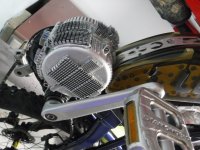eagercyclist
1 mW
- Joined
- Mar 30, 2021
- Messages
- 11
What kills motors/controllers? Current or power?
I have a BBS01B controller/motor package (not sure what the motor code is). The cadence is a bit slow and I will be fitting a 48V BBS02B controller/battery hopefully within a couple of weeks while using the BBS01B motor. (Yes I could upgrade the whole thing but where's the fun in that?)
I will be doing some experimenting with a temperature probe to check what might be reasonable power to run through (100% keep current, essentially unrestricted max speed) bearing in mind the design intention to fade max power out and thus only use max power for short periods. Currently accessing 250-350W continuous power (7-9A at ~36V) over 10-15 minutes with a few brief pauses seems to do no more than make the outside of the motor/controller casing mildly warm. Typical cadence estimated at 70-80rpm and certainly not below 60 for more than a few seconds at a time.
Hopefully I will establish an answer to the current/power question by monitoring temperatures at a certain current in 36V prior to switching to 48V and then comparing.
Has anyone pushed the BBS01B motor to its limits? If so, what were the limits?
People talk about the windings being different between the BBS02B and 01B motors, to compensate for the higher voltage and keep motor speed and pedal cadence at an appropriate speed. This seems illogical to me since the BBS02B operates approximately 30% (maybe slightly more) faster (surrogate measure of max cadence) than the BBS01B which is in keeping with a 30% boost in voltage (10s to 13s) so why would the windings have been altered? And if they have been altered, why have they been altered upwards - if they think 85rpm is appropriate for BBS01B, why is 115rpm appropriate for BBS02B?
I'm hoping by increasing to 48V but keeping current the same or slightly less I can access more power but with less excess heat generated with lower risk of blowing something.. thoughts?
Sorry for the waffle..
[TLDR]
1. What kills motors/controllers? Current or power? (Secondary question: does heat build up more with increased current and same voltage vs increased voltage and same current?)
2. Has anyone pushed the BBS01B motor to its limits? If so, what were the limits?
I have a BBS01B controller/motor package (not sure what the motor code is). The cadence is a bit slow and I will be fitting a 48V BBS02B controller/battery hopefully within a couple of weeks while using the BBS01B motor. (Yes I could upgrade the whole thing but where's the fun in that?)
I will be doing some experimenting with a temperature probe to check what might be reasonable power to run through (100% keep current, essentially unrestricted max speed) bearing in mind the design intention to fade max power out and thus only use max power for short periods. Currently accessing 250-350W continuous power (7-9A at ~36V) over 10-15 minutes with a few brief pauses seems to do no more than make the outside of the motor/controller casing mildly warm. Typical cadence estimated at 70-80rpm and certainly not below 60 for more than a few seconds at a time.
Hopefully I will establish an answer to the current/power question by monitoring temperatures at a certain current in 36V prior to switching to 48V and then comparing.
Has anyone pushed the BBS01B motor to its limits? If so, what were the limits?
People talk about the windings being different between the BBS02B and 01B motors, to compensate for the higher voltage and keep motor speed and pedal cadence at an appropriate speed. This seems illogical to me since the BBS02B operates approximately 30% (maybe slightly more) faster (surrogate measure of max cadence) than the BBS01B which is in keeping with a 30% boost in voltage (10s to 13s) so why would the windings have been altered? And if they have been altered, why have they been altered upwards - if they think 85rpm is appropriate for BBS01B, why is 115rpm appropriate for BBS02B?
I'm hoping by increasing to 48V but keeping current the same or slightly less I can access more power but with less excess heat generated with lower risk of blowing something.. thoughts?
Sorry for the waffle..
[TLDR]
1. What kills motors/controllers? Current or power? (Secondary question: does heat build up more with increased current and same voltage vs increased voltage and same current?)
2. Has anyone pushed the BBS01B motor to its limits? If so, what were the limits?


